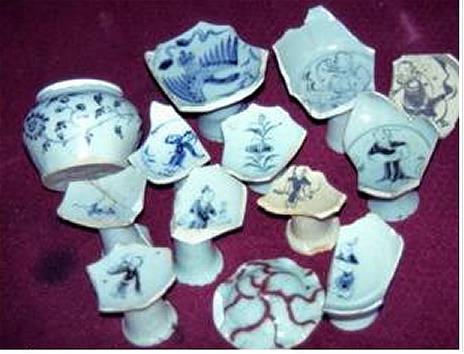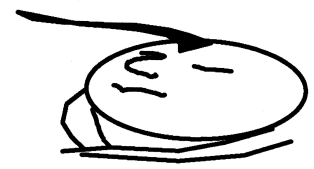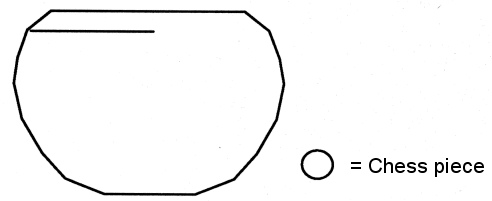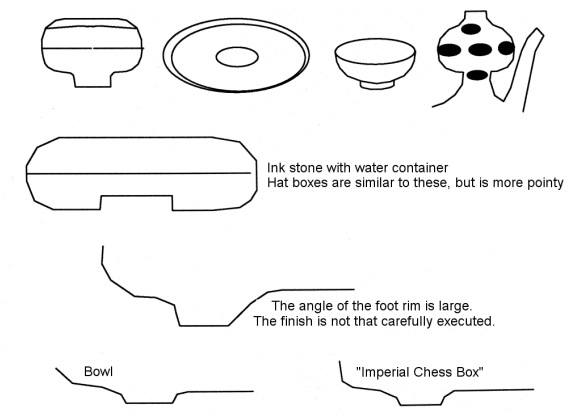
Meeting with Dr. Liu at the Longzhu (dragon's pearl) pavilion at Zhushan. He brought an article he had written in a Japanese publication in 1983: "Trade Ceramics Studies No. 3, ISSN 0286 - 343X, Japan Society for the Study of Oriental Trade Ceramics. Dr. Liu pointed out during the conversation that in the 1400s trading between nations was not controlled by the emperor.
/ foot note / 2 Liu aa. page 54 ff, spec 70-71.
Found at Luomaqiao, a neck from a larger object, quite unique, for Islamic purposes. The decoration is more lively than during the Ming. The color ranges in our samples from dark blue to intense clear dark blue. The most distinctive feature is the vigorous brush strokes that go from the thinnest thin to full flowing brushwork and washed surfaces. Blades are painted as full strokes. Some parts are spattered or powdered.

Fig. 26. Leaf drawing on a fragment of a lid. Yuan (1279-1368)
Some observations: The inside is cut, turned, etc. The distinguishing feature is that the marks of the tools are clear. A portion of the cobalt used must be imported, specifically that on the piece of a cover with the above depicted blade. A radiantly beautiful shard from a large dish came from Hutian and was painted with imported cobalt. During the late Yuan the pigment degraded due to the war. A red striped lid had been found at Luomaqiao. Nobody knew from where the actual pot came.

Fig. 27. Stemcup feet from the Yuan to early Ming.
Those with painted rings were from the Yuan, while the modeled ones were from Ming

A number of stemcup feet from Yuan to early Ming were all found on Zhushan. It was assumed that one with a dragon, was imperial. The high feet were often decorated with parallel concentric rings. Some were painted, others modeled in a manner that appeared to imitate bamboo. Those with painted rings were from the Yuan, while the modeled ones were from Ming, they said. On these cups was a dancing figure with his hair set as a thin pigtail, this motif was of a special dance that was related only to the mongol Yuan dynasty.

Fig. 27. A dancing figure with a thin hair pigtail is special and occur only during the Yuan.
Something like a rule of thumb; Shufu-type = millions of small invisible bubbles in the glaze. Not Shufu type = large bubbles.
Hutian = Lake fields
The Yangmeiting , that Brankstone was telling about, is next to Hutian, on the other side of the Nanhe river.
Some observation: Three additional objects we saw was a baluster urn with lid. A ladle, one large and one small bowl. A chrysanthemum on a Yuan piece had a single set of petals. Items from Yuan has been found in three places: Zhushan, Luomaqiao and Hutian. There is no evidence that the production of blue and white porcelain was begun before Yuan. Of the factory managers during the Yuan, only one was Chinese. Other nationalities were Mongols, Persians, Japanese plus a range of other. Yuan emperors were more interested in Islam and Mongolia than of China. The first emperor of the Yuan could not speak Chinese. The second emperor became interested in painting, calligraphy, and chess and learned some Chinese. The small bowl is an example of Mongols influence. During Yuan the size of wine cups are reduced due to that the alcohol strength is increased. During the Yuan wine is = arab wine. When the Mongolian emperor starts ruling the entire country, culture was affected at all levels. Yuan Guanyao was used by the emperor. Additional findings were some boxes, one equipped with a name in Mongolian writing invented by a Tibetan monk.

Fig 28. Chess box found at Zhushan for the second emperor of Yuan

Fig. 29. Items from Yuan Dynasty, found at Luomaqiao.